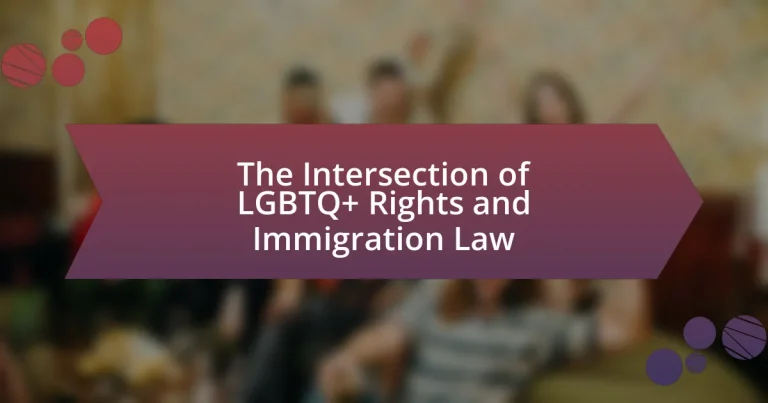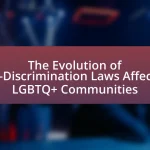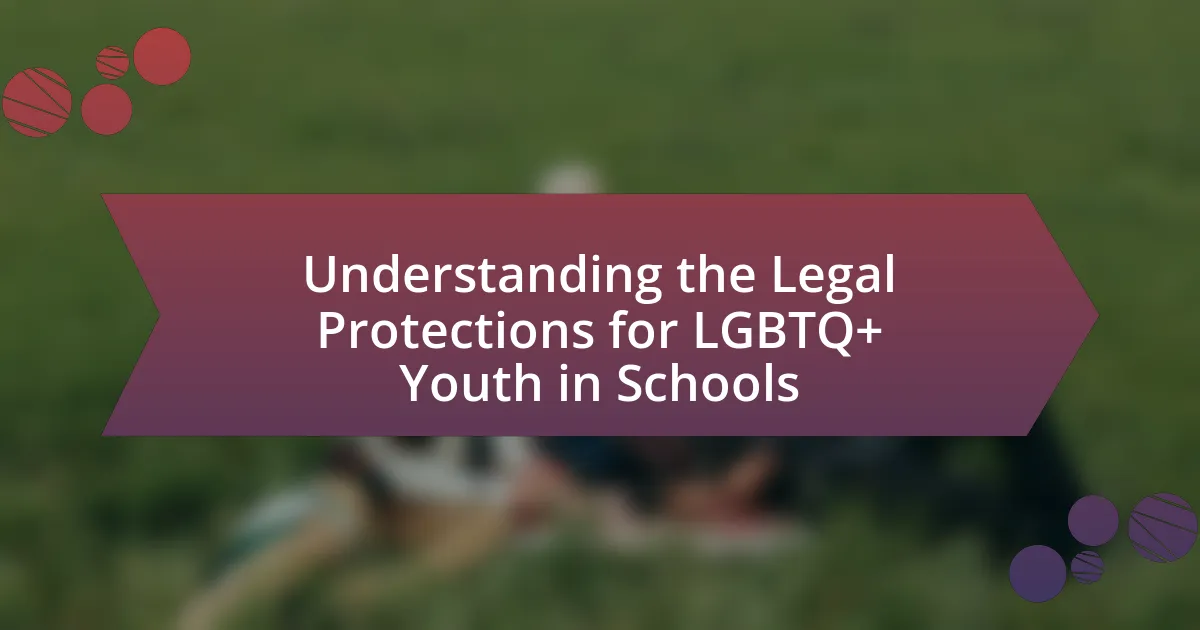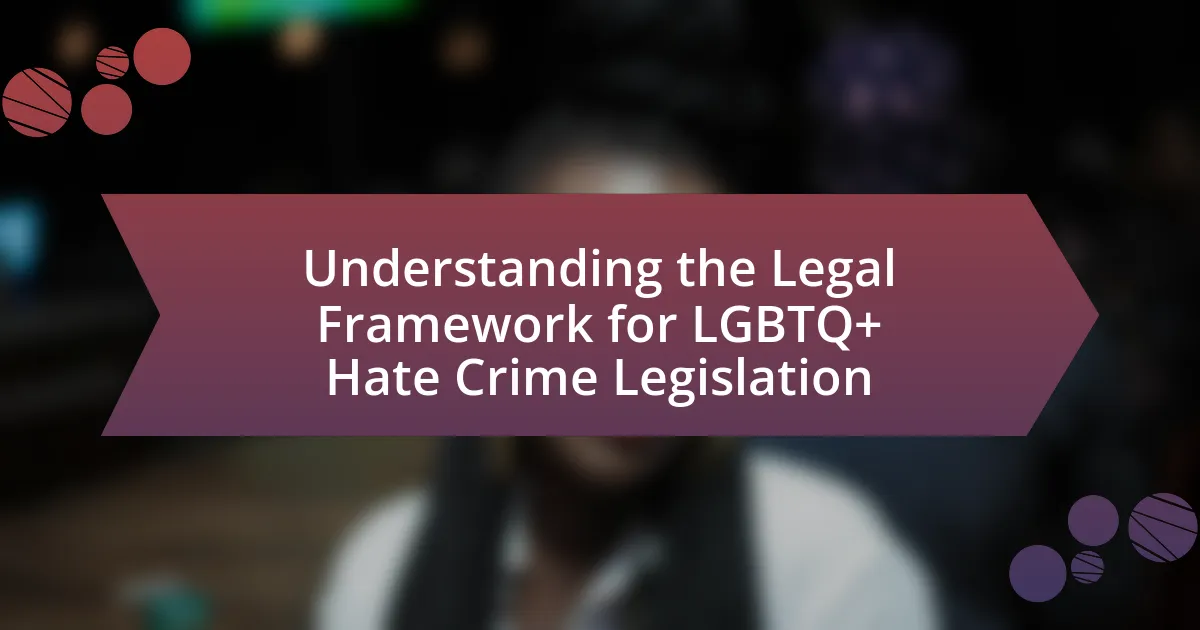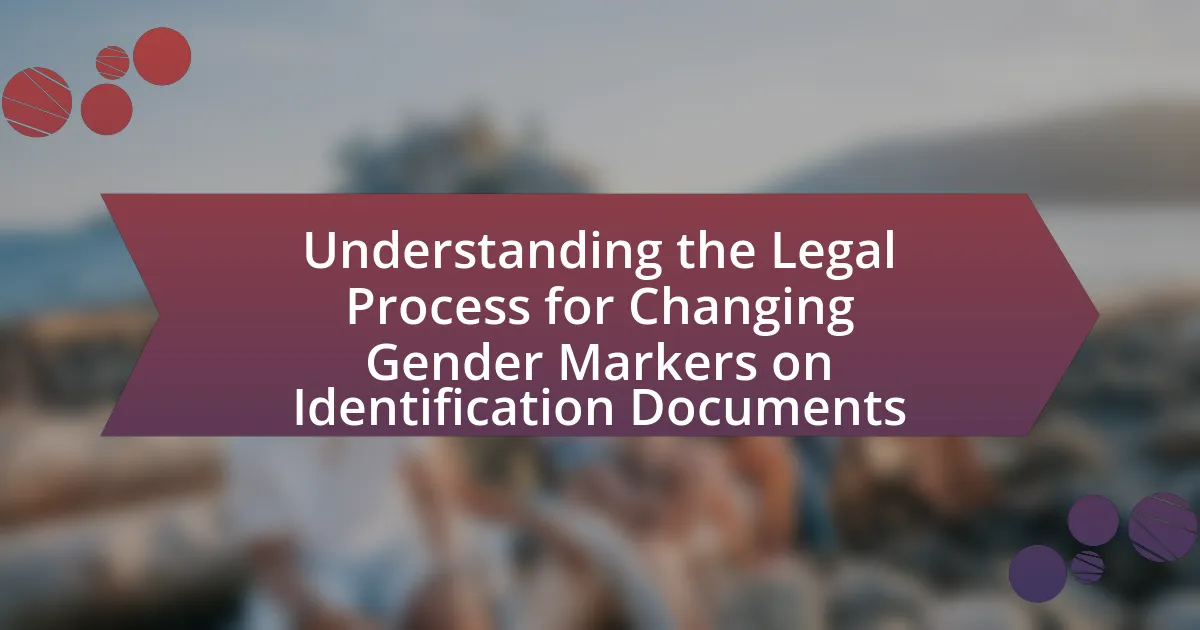The article examines the intersection of LGBTQ+ rights and immigration law, highlighting the legal recognition and protection of LGBTQ+ individuals within immigration processes. It discusses the significance of asylum claims for LGBTQ+ individuals facing persecution in their home countries, the influence of societal attitudes on immigration policies, and the specific legal protections available under U.S. law. Additionally, the article addresses the challenges LGBTQ+ immigrants encounter, the impact of political climate on their rights, and the role of advocacy groups in responding to policy changes. It concludes by exploring future trends and best practices for supporting LGBTQ+ immigrants in navigating the complexities of immigration law.

What is the Intersection of LGBTQ+ Rights and Immigration Law?
The intersection of LGBTQ+ rights and immigration law involves the legal recognition and protection of LGBTQ+ individuals within immigration processes. This intersection is significant as many LGBTQ+ individuals face persecution in their home countries due to their sexual orientation or gender identity, which can qualify them for asylum in the United States under the Refugee Act of 1980. According to the U.S. Citizenship and Immigration Services, applicants must demonstrate a well-founded fear of persecution based on their LGBTQ+ status to be granted asylum. Additionally, the Supreme Court’s ruling in Obergefell v. Hodges (2015) established the right to same-sex marriage, further influencing immigration benefits for same-sex couples. These legal frameworks highlight the critical need for protections that address the unique challenges faced by LGBTQ+ immigrants.
How do LGBTQ+ rights influence immigration policies?
LGBTQ+ rights significantly influence immigration policies by shaping legal frameworks that protect individuals from persecution based on sexual orientation and gender identity. Countries that recognize LGBTQ+ rights often implement asylum laws that allow individuals fleeing persecution due to their sexual orientation or gender identity to seek refuge. For example, the United States recognizes LGBTQ+ individuals as a particular social group under the asylum framework, allowing them to apply for asylum if they can demonstrate a well-founded fear of persecution in their home countries. This legal recognition is supported by international human rights standards, such as the Yogyakarta Principles, which affirm the rights of LGBTQ+ individuals and encourage states to protect them from discrimination and violence.
What specific legal protections exist for LGBTQ+ immigrants?
LGBTQ+ immigrants are afforded specific legal protections under U.S. immigration law, primarily through asylum and refugee status based on persecution due to sexual orientation or gender identity. The U.S. Citizenship and Immigration Services (USCIS) recognizes that LGBTQ+ individuals may face severe discrimination, violence, or persecution in their home countries, which can qualify them for asylum if they can demonstrate a well-founded fear of such treatment. Additionally, the 2013 U.S. Supreme Court ruling in United States v. Windsor, which struck down the Defense of Marriage Act, has further solidified the rights of same-sex couples in immigration matters, allowing for spousal sponsorship and other immigration benefits. These legal frameworks ensure that LGBTQ+ immigrants have avenues to seek protection and remain in the U.S. when facing threats in their countries of origin.
How do these protections vary by country?
Protections for LGBTQ+ individuals vary significantly by country, influenced by cultural, legal, and political factors. For instance, countries like Canada and the Netherlands offer comprehensive legal protections, including anti-discrimination laws and marriage equality, while nations such as Saudi Arabia and Uganda impose severe penalties, including imprisonment or even death, for same-sex relationships. According to the International Lesbian, Gay, Bisexual, Trans and Intersex Association (ILGA), as of 2021, 69 countries still criminalize same-sex relationships, highlighting the stark contrast in protections globally. This disparity affects immigration policies, as individuals from countries with harsh anti-LGBTQ+ laws may seek asylum in more accepting nations, further complicating the intersection of LGBTQ+ rights and immigration law.
Why is the intersection of these two areas significant?
The intersection of LGBTQ+ rights and immigration law is significant because it addresses the unique vulnerabilities faced by LGBTQ+ individuals in the immigration process. Many LGBTQ+ immigrants flee persecution in their home countries due to their sexual orientation or gender identity, making their legal status in a new country critical for their safety and well-being. For instance, the U.S. Citizenship and Immigration Services recognizes that LGBTQ+ individuals may qualify for asylum based on a well-founded fear of persecution, highlighting the legal acknowledgment of their specific needs. This intersection is crucial as it shapes policies that protect LGBTQ+ immigrants from discrimination and violence, ensuring their rights are upheld in the immigration system.
What historical events have shaped this intersection?
The intersection of LGBTQ+ rights and immigration law has been shaped by several key historical events, including the Stonewall Riots of 1969, which marked a significant turning point in the LGBTQ+ rights movement, leading to increased visibility and advocacy for LGBTQ+ individuals. Additionally, the 1990 Immigration Act, which allowed for the inclusion of same-sex partners in immigration applications, represented a crucial legal recognition of LGBTQ+ relationships. The Defense of Marriage Act (DOMA) in 1996 initially restricted federal recognition of same-sex marriages, but its eventual repeal in 2013 by the Supreme Court in United States v. Windsor further solidified the rights of LGBTQ+ individuals in immigration contexts. These events collectively illustrate the evolving legal landscape and the ongoing struggle for equality within immigration law for LGBTQ+ individuals.
How do societal attitudes impact LGBTQ+ immigration rights?
Societal attitudes significantly impact LGBTQ+ immigration rights by influencing legislation and policy enforcement. When societies exhibit acceptance and support for LGBTQ+ individuals, governments are more likely to implement inclusive immigration policies that recognize same-sex partnerships and asylum claims based on sexual orientation. For instance, countries like Canada and the Netherlands have established legal frameworks that protect LGBTQ+ immigrants, reflecting positive societal attitudes. Conversely, in regions where negative attitudes prevail, such as in some parts of Eastern Europe and Africa, LGBTQ+ individuals often face discriminatory immigration laws and barriers to asylum, as evidenced by the persecution reported in countries like Uganda and Russia. This correlation between societal attitudes and immigration rights underscores the importance of public perception in shaping legal protections for LGBTQ+ individuals.
What challenges do LGBTQ+ immigrants face?
LGBTQ+ immigrants face significant challenges including discrimination, legal barriers, and lack of access to resources. Discrimination often manifests in the form of hostility from immigration authorities and societal stigma, which can lead to mental health issues and social isolation. Legal barriers arise from complex immigration laws that may not recognize LGBTQ+ relationships or asylum claims based on sexual orientation or gender identity. Additionally, many LGBTQ+ immigrants struggle to find supportive community resources, such as legal aid and healthcare, which are crucial for their well-being and integration into society. According to a report by the Williams Institute, LGBTQ+ immigrants are more likely to experience violence and discrimination compared to their heterosexual counterparts, highlighting the urgent need for tailored support and policy reform.
What are the common legal hurdles encountered?
Common legal hurdles encountered in the intersection of LGBTQ+ rights and immigration law include discrimination based on sexual orientation or gender identity, lack of recognition for same-sex relationships in immigration processes, and challenges in obtaining asylum based on persecution due to LGBTQ+ status. These hurdles are evidenced by the fact that many countries do not provide adequate legal protections for LGBTQ+ individuals, leading to increased vulnerability during immigration proceedings. For instance, the U.S. Citizenship and Immigration Services has faced criticism for inconsistent application of asylum laws related to LGBTQ+ claims, highlighting the complexities and barriers faced by individuals seeking refuge from persecution.
How do cultural factors affect the experiences of LGBTQ+ immigrants?
Cultural factors significantly affect the experiences of LGBTQ+ immigrants by shaping their acceptance, integration, and access to resources in their new environments. For instance, immigrants from countries with strong anti-LGBTQ+ sentiments may face heightened discrimination and isolation in their host countries, impacting their mental health and social support networks. Research indicates that LGBTQ+ individuals from cultures that stigmatize non-heteronormative identities often experience internalized homophobia, which can hinder their ability to seek help or build community in their new surroundings. Additionally, cultural norms regarding gender and sexuality can influence the legal protections available to LGBTQ+ immigrants, as some countries may have more inclusive policies than others. This interplay of cultural background and local societal attitudes ultimately shapes the overall well-being and integration experiences of LGBTQ+ immigrants.

How do Current Immigration Laws Affect LGBTQ+ Rights?
Current immigration laws significantly impact LGBTQ+ rights by often failing to recognize the unique vulnerabilities faced by LGBTQ+ individuals in their home countries. Many LGBTQ+ individuals seek asylum in the United States due to persecution based on their sexual orientation or gender identity, yet the legal framework can be complex and inconsistent. For instance, the U.S. Citizenship and Immigration Services requires asylum seekers to demonstrate a well-founded fear of persecution, which can be challenging for LGBTQ+ individuals who may not have adequate documentation or support to prove their claims. According to a 2020 report by the Williams Institute, LGBTQ+ asylum seekers face higher rates of rejection compared to their heterosexual counterparts, highlighting systemic biases within the immigration system. This disparity underscores the need for reforms that explicitly address the rights and protections of LGBTQ+ individuals within immigration laws.
What are the key immigration laws relevant to LGBTQ+ individuals?
Key immigration laws relevant to LGBTQ+ individuals include the Immigration and Nationality Act (INA), which allows for asylum claims based on persecution due to sexual orientation or gender identity. The U.S. Citizenship and Immigration Services (USCIS) recognizes that LGBTQ+ individuals may face unique risks in their home countries, thus enabling them to seek protection. Additionally, the Defense of Marriage Act (DOMA) was struck down in 2013, allowing same-sex couples to sponsor their spouses for immigration benefits, which was previously denied. These legal frameworks demonstrate a growing recognition of the rights of LGBTQ+ individuals within the immigration system, reflecting changes in societal attitudes and legal interpretations.
How do these laws differ from general immigration laws?
Laws concerning LGBTQ+ rights in immigration differ from general immigration laws primarily in their focus on protecting individuals from persecution based on sexual orientation or gender identity. General immigration laws typically address criteria such as family reunification, employment, and asylum without specific provisions for LGBTQ+ individuals. For instance, the U.S. Citizenship and Immigration Services recognizes that LGBTQ+ individuals may face unique risks in their home countries, which can qualify them for asylum under the 1951 Refugee Convention, a consideration not explicitly outlined in standard immigration statutes. This distinction highlights the necessity for tailored legal frameworks to address the specific vulnerabilities faced by LGBTQ+ immigrants.
What role do asylum claims play for LGBTQ+ immigrants?
Asylum claims serve as a critical mechanism for LGBTQ+ immigrants seeking protection from persecution based on their sexual orientation or gender identity. These claims allow individuals to escape environments where they face violence, discrimination, or threats to their safety due to their identity. According to the United Nations High Commissioner for Refugees (UNHCR), LGBTQ+ individuals are often subjected to severe human rights abuses in many countries, making asylum a vital option for their survival and well-being. In the United States, for instance, the asylum process has been utilized by thousands of LGBTQ+ individuals who demonstrate a well-founded fear of persecution, highlighting the essential role of asylum claims in safeguarding their rights and lives.
How do changes in political climate influence LGBTQ+ immigration rights?
Changes in political climate significantly influence LGBTQ+ immigration rights by altering policies and enforcement practices that protect or hinder LGBTQ+ individuals seeking asylum or residency. For instance, during more progressive administrations, there is often an increase in protections for LGBTQ+ asylum seekers, as seen in the Obama administration’s efforts to recognize persecution based on sexual orientation as a valid basis for asylum. Conversely, under more conservative administrations, such as during the Trump administration, there were rollbacks on protections, including attempts to redefine the criteria for asylum eligibility, which adversely affected LGBTQ+ individuals. These shifts in political leadership directly impact the legal frameworks and societal attitudes towards LGBTQ+ immigrants, shaping their access to safety and legal recognition.
What recent legislative changes have impacted these rights?
Recent legislative changes impacting LGBTQ+ rights in immigration law include the U.S. Citizenship Act of 2021, which aims to provide a pathway to citizenship for undocumented immigrants, including those in same-sex relationships. This act specifically addresses the need for equitable treatment of LGBTQ+ individuals in immigration processes, recognizing the unique challenges they face. Additionally, the repeal of the “transgender military ban” and the Biden administration’s commitment to uphold protections for LGBTQ+ asylum seekers further solidify these rights. These changes reflect a broader trend towards inclusivity and recognition of LGBTQ+ individuals within immigration policies.
How do advocacy groups respond to shifts in immigration policy?
Advocacy groups respond to shifts in immigration policy by mobilizing resources to protect the rights of affected individuals, particularly marginalized communities such as LGBTQ+ immigrants. These organizations often engage in public campaigns, legal challenges, and lobbying efforts to influence policy changes and ensure that the rights of immigrants are upheld. For instance, during the implementation of the “Muslim Ban” in 2017, groups like the American Civil Liberties Union (ACLU) and Lambda Legal quickly organized protests and filed lawsuits to challenge the legality of the policy, highlighting its discriminatory impact on LGBTQ+ individuals from affected countries. Such actions demonstrate how advocacy groups actively work to counter adverse immigration policies and advocate for inclusive reforms.

What are the Future Trends in LGBTQ+ Rights and Immigration Law?
Future trends in LGBTQ+ rights and immigration law indicate a growing recognition of the need for inclusive policies that protect LGBTQ+ individuals seeking asylum and immigration benefits. As global awareness of LGBTQ+ issues increases, countries are likely to adopt more comprehensive legal frameworks that explicitly recognize persecution based on sexual orientation and gender identity as valid grounds for asylum. For instance, the United Nations High Commissioner for Refugees (UNHCR) has emphasized the importance of protecting LGBTQ+ refugees, highlighting that many face violence and discrimination in their home countries. Additionally, legal precedents in various jurisdictions, such as the U.S. Supreme Court’s ruling in Obergefell v. Hodges, which legalized same-sex marriage, suggest a trend toward broader civil rights protections that may influence immigration policies. These developments indicate a shift towards more equitable treatment of LGBTQ+ individuals in immigration law, reflecting societal changes and advocacy efforts.
How might global movements affect LGBTQ+ immigration rights?
Global movements can significantly enhance LGBTQ+ immigration rights by advocating for policy changes and increased protections. These movements, such as Pride marches and international coalitions, raise awareness about the persecution faced by LGBTQ+ individuals in various countries, leading to pressure on governments to reform immigration laws. For instance, the United Nations has recognized sexual orientation and gender identity as valid grounds for asylum, influencing national policies in countries like Canada and the United States to provide refuge for LGBTQ+ individuals fleeing persecution. Additionally, global advocacy efforts have resulted in the establishment of legal frameworks that protect LGBTQ+ rights, thereby facilitating safer immigration pathways for affected individuals.
What role do international treaties play in shaping these rights?
International treaties play a crucial role in shaping LGBTQ+ rights by establishing legal frameworks that promote equality and protect against discrimination. For instance, treaties such as the International Covenant on Civil and Political Rights (ICCPR) and the Convention on the Elimination of All Forms of Discrimination Against Women (CEDAW) set international standards that member states are encouraged to adopt, thereby influencing domestic laws and policies related to LGBTQ+ rights. These treaties obligate countries to respect, protect, and fulfill the rights of individuals, including those based on sexual orientation and gender identity, thereby providing a basis for legal recourse and advocacy. The implementation of these treaties has been linked to advancements in LGBTQ+ rights in various countries, demonstrating their effectiveness in promoting equality and protection under the law.
How can cross-border collaborations enhance protections for LGBTQ+ immigrants?
Cross-border collaborations can enhance protections for LGBTQ+ immigrants by creating unified legal frameworks and support systems that address their unique vulnerabilities. These collaborations enable countries to share best practices, resources, and information, which can lead to more effective asylum processes and legal protections tailored to the needs of LGBTQ+ individuals. For instance, the Global Refugee Forum in 2019 highlighted the importance of international cooperation in improving the safety and rights of marginalized groups, including LGBTQ+ refugees, by promoting inclusive policies and practices. Such collaborative efforts can also facilitate access to essential services, such as healthcare and legal assistance, thereby improving the overall well-being and security of LGBTQ+ immigrants.
What best practices can be adopted to support LGBTQ+ immigrants?
To support LGBTQ+ immigrants, organizations and governments should implement inclusive policies, provide culturally competent legal assistance, and ensure access to safe housing and healthcare. Inclusive policies should explicitly protect LGBTQ+ individuals from discrimination in immigration processes, as evidenced by the 2011 U.S. Department of Homeland Security’s guidance recognizing LGBTQ+ persecution as a valid basis for asylum. Culturally competent legal assistance is crucial, as it helps LGBTQ+ immigrants navigate complex immigration laws while addressing their unique challenges, supported by studies showing that tailored legal services improve outcomes for marginalized groups. Additionally, ensuring access to safe housing and healthcare can mitigate the risks of homelessness and health disparities, which LGBTQ+ immigrants often face, as highlighted by the 2020 report from the Williams Institute indicating higher rates of mental health issues among LGBTQ+ immigrants compared to their heterosexual counterparts.
How can legal professionals better advocate for LGBTQ+ rights in immigration cases?
Legal professionals can better advocate for LGBTQ+ rights in immigration cases by employing a comprehensive understanding of both immigration law and the specific challenges faced by LGBTQ+ individuals. This includes utilizing country conditions evidence that highlights the risks of persecution based on sexual orientation or gender identity in the applicant’s home country, which is crucial for asylum claims. For instance, the U.S. Department of State’s Country Reports on Human Rights Practices provide detailed accounts of human rights abuses against LGBTQ+ individuals in various countries, serving as vital evidence in legal arguments. Additionally, legal professionals should collaborate with LGBTQ+ advocacy organizations to stay informed about the latest developments in both immigration and LGBTQ+ rights, ensuring that their advocacy is grounded in current legal standards and social contexts.
What resources are available for LGBTQ+ immigrants seeking legal assistance?
LGBTQ+ immigrants seeking legal assistance can access various resources, including organizations like the Immigration Equality, which provides legal services specifically for LGBTQ+ individuals facing immigration issues. Additionally, the Lambda Legal Defense and Education Fund offers resources and legal support for LGBTQ+ immigrants, focusing on their rights and protections under the law. The Human Rights Campaign also provides information and referrals for legal assistance tailored to the needs of LGBTQ+ immigrants. These organizations are recognized for their commitment to advocating for the rights of LGBTQ+ individuals and have established programs to assist with legal challenges related to immigration.
